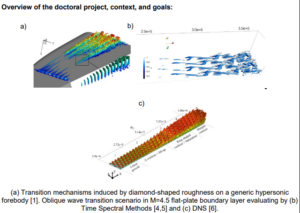Thèse “Optimal design of wall roughnesses / wall-heat fluxes to delay / promote transition in supersonic boundary layers”
Thèse posted 3 mois il y aDescription
In the context  of future hypersonic vehicles, a significant challenge revolves around triggering the transition from laminar to turbulent flow in the boundary layers encountered within the air intakes.
of future hypersonic vehicles, a significant challenge revolves around triggering the transition from laminar to turbulent flow in the boundary layers encountered within the air intakes.
This challenge is particularly crucial when laminar boundary layers interact with the shock waves necessary for decelerating the incoming air flow. Achieving this transition is exceptionally difficult due to the high Mach numbers expected for these vehicles (potentially reaching M=6 or M=8) and the low Reynolds numbers associated with high-altitude flight (tens of kilometers). These conditions dampen the instability mechanisms needed for the transition. Consequently, the development of effective boundary layer transition mechanisms becomes a pivotal aspect of hypersonic vehicle
design (see figure a).
While predicting and optimizing linear perturbations in hypersonic flows is well-established, it is known from numerous studies in incompressible conditions that the shift from a laminar to turbulent state is fundamentally governed by nonlinear interactions. For example, in undisturbed environments, the 2D Tollmien-Schlichting instability eventually gives way to a secondary instability, leading to the formation of streaks and, ultimately, the onset of turbulence. Therefore, an ideal transition mechanism must effectively trigger both the Tollmien-Schlichting wave and the secondary instability. In essence, a nonlinear optimization process is required to achieve the ultimate objective: inducing the transition from laminar to turbulent flow.
For incompressible boundary layers, researchers have successfully employed a modified form of the Navier-Stokes equations called Harmonic Balanced equations for this optimization [2]. Previous research has shown promising results in using numerical methods to identify optimal roughness elements and wall displacement control strategies for airfoils, such as the NACA0012 [3]. In the case of compressible equations, similar optimization techniques based on Time Spectral Methods for both time and spanwise directions can be applied. An efficient code known as BROADCAST has been developed for this purpose [4]. An adjoint-based framework [2,5] has been employed in both incompressible and compressible scenarios to finally optimize volumetric and wall-induced perturbations of finite amplitude that either maximize or minimize the mean-shear of the boundary layer, thereby influencing the transition to a turbulent state (see figure b).
The overarching goals of this thesis encompass the following:
1. Developing, implementing, and evaluating boundary conditions that represent various types of wall control and wall roughness, including heating, cooling, and wall displacement, with specific amplitude values.
2. Conducting nonlinear optimization processes to design roughness elements of specified amplitudes that can effectively induce the transition from laminar to turbulent flow.
3. Performing nonlinear min-max optimizations to determine the most effective 3D steady heat-flux and roughness patterns for wall control, as well as identifying the most challenging disturbance environments (involving roughness and free-stream conditions) that can delay the transition to turbulence.
4. Validating the proposed strategies and mechanisms through Direct Numerical Simulations (DNS) where the roughness elements are included in the mesh, allowing for a detailed analysis of the physical processes involved in the transition from laminar to turbulent flow (see figure c).
References:
[1] Lefieux, J., DNS study of roughness-induced transition in hypersonic flows, Université ParisSaclay, 2021.
[2] Rigas, G., Sipp, D., Colonius, T. Nonlinear input/output analysis: application to boundary layer transition. J. Fluid Mech., 911, A15, 2021.
[3] Kitzinger, E., Sipp, D., Marquet, O. and Piot P., Receptivity of swept-aerofoil flows to small amplitude wall roughness using a transfer function from wall displacements to induced velocity perturbations. Accepted in Flow.
[4] Poulain, A., Content, C., Sipp, D., Rigas, G. and Garnier, E. BROADCAST: A high-order compressible CFD toolbox for stability and sensitivity using Algorithmic Differentiation. Comp. Phys. Comm., 283, 108557, 2023.
[5] Poulain, A., Content, C., Rigas, G., Garnier, E., Sipp D. Adjoint-based linear sensitivity of a supersonic boundary layer to steady wall blowing-suction/heating-cooling, Submitted to JFM.
[6] Schioppa, A., Optimal Laminar-to-Turbulence Transition Scenario in Hypersonic Boundary Layer. Rapport de stage ONERA, ONERA TH 2023-97, 2023


